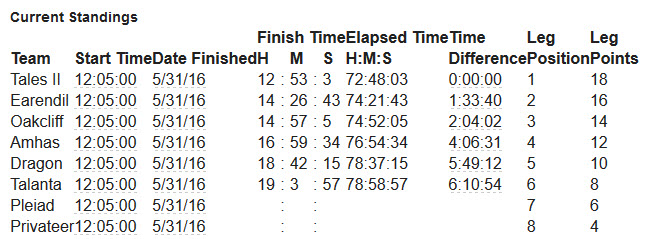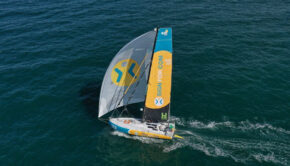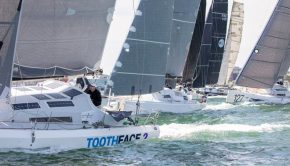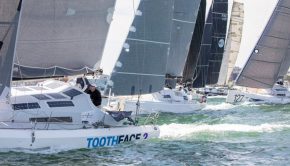Tales II Wins First Stage of Atlantic Cup
Published on May 31st, 2016
Brooklyn, NY (May 31, 2016; Day 4) – With a fleet of nine Class 40s competing in the Atlantic Cup, #123 – Tales II skippered by Gonzalo Botín and Pablo Santurde crossed the finish line first at 12:53:03 p.m. ET today with an elapsed time of 72:48:03, to complete the 648 nautical mile first off-shore leg from Charleston, S.C. to Brooklyn, N.Y.
Spain’s #123 Tales II finished 1 hour 33 minutes and 30 seconds ahead of #145 Eärendil (74:21:43) in second, followed by the team of #118 Oakcliff Racing (74:52:05).
The race began at 12:05 p.m. on Saturday, May 28 from the Charleston Maritime Center, with teams from six countries leaving Charleston harbor just ahead of Tropical Storm Bonnie which set up a difficult first 24-hours. Top wind speeds reported in the first night were 35 knots with a very confused sea state.
Tales II moved into the lead just before exiting the jetties in Charleston and they held their first place position throughout the race, going on to set a new course record for the first leg.
Gonzalo Botín, Tales II Skipper
“The first night was quite tough…but the worst part was today getting from Sandy Hook [NJ] up here. Our top speed was 25 knots over the ground, we had four knots of current, but when we saw the numbers we said wow, we have like Volvo speeds. It’s a marvelous leg, I think it takes you from, well you are very lucky in the states, because you have the full North Atlantic so you have Hatteras, then the Gulf Stream, well you have everything, it’s incredible the change, because you get the Labrador current here and it starts getting cold and foggy, you know two days ago I was in shorts and then it gets cold. It’s a very interesting place. The course is great, I think the waters in which we sailed were magnificent from navigation to weather, I think it rates very high compared to other events.”
Catherine Pourre, Eärendil Skipper
“Yes, we are happy with our second place finish, but I think we could have done better so we will try next time. We did have some problems with our autopilot where we gybed and it broke the mainsail halyard. We were under speed of 16-19 knots then this happened and then we took half an hour to an hour for Antoine to go up [the mast] to replace the line and during this time were under solent so we were going 6-9 knots. So it took about 10 miles for this operation, it was a long operation and it cost us miles. It’s a nice course. The finish is a good place, except that when we got near there was a deep fog and we thought ‘Ah my God, it’s going to be like that up to New York so we’re not going to see anything!’ But a few miles before the entrance it all cleared and it was a great view”
Libby Greenhalgh, Oakcliff Racing
“It was pretty interesting starting the race having not sailed together or set any form of A-sail or kite. It was pretty windy we saw 25-30 knots most of the time. We toughed it out on our full main and our solent, but when we went to change it became very apparent to us we haven’t done this before and it takes us a stack load of time and very quickly we lost miles. I think that’s the biggest thing with double-handed sailing, it’s just tough and your just physically knackered.
“It’s amazing actually for a 40-foot yacht under that sail configuration, which once it picks up it really gets going, it doesn’t even feel like anything [top speed was 24.3 knots]. I think the course is fantastic, lot of opportunity, you’ve got the Gulf Stream to play with and sometimes that kicks up all sorts of weather. And we really had everything, so there were lots of opportunities to take, it wasn’t a go out follow race.”
The next stage is a doublehanded leg starting on June 4, taking the fleet 360 nm from New York, NY to Portland, ME. The final stage on June 10-11 will have 6-person teams complete an inshore series of races in Portland.
Event website – Tracker – Facebook
About The Atlantic Cup
The Atlantic Cup presented by 11th Hour Racing is, at 1,045 nautical miles, the longest offshore in the Western Atlantic. The Atlantic Cup was created and is owned by Manuka Sports Event Management. It started in 2011 as a concept event and grew to a multi-stage race. Since its inception, the Atlantic Cup has aimed to be the most environmentally responsible sailing race in the United States. The race is sailed solely in Class40s, a monohull race boat designed for shorthanded racing.
The first doublehanded leg starting May 28 takes the fleet 648 nm from Charleston, SC to Brooklyn, NY, with the second doublehanded leg starting June 4 for 360 nm to Portland, ME. The final stage on June 10-11 will have 6-person teams complete an inshore series of races in Portland.
The Atlantic Cup ran annually in May from 2011 through 2014. After 2014, the race moved to a biennial event. The course in 2011 was a sprint from New York to Newport with an inshore series in Newport. From 2012-2014, the race was a three-stage event that started in Charleston, South Carolina included a stop-over in New York City and finished in Newport, Rhode Island. In 2016, the Atlantic Cup will continue to comprise of three legs, with stop-overs in Charleston, S.C., Brooklyn, N.Y., and for the first time, Portland, Maine.
Source: Atlantic Cup










 We’ll keep your information safe.
We’ll keep your information safe.